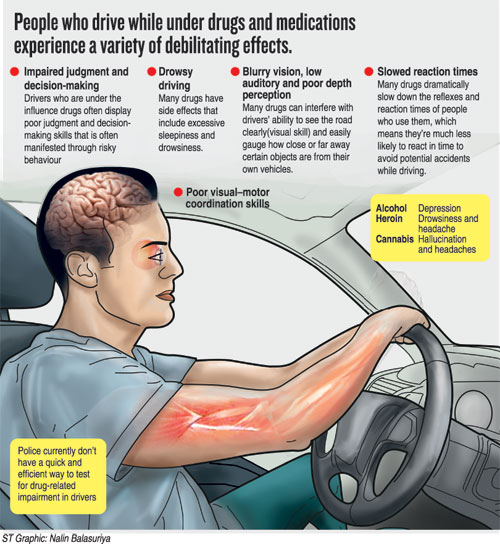News
Driving under the influence of drugs poses bigger dangers than drunk driving
 The large amount of narcotics flowing into the country has theTraffic Police in a dilemma on how to stem the number of people driving under the influence of narcotics.
The large amount of narcotics flowing into the country has theTraffic Police in a dilemma on how to stem the number of people driving under the influence of narcotics.
Traffic police emphasised that, although early detection of motorists driving under the influence of drugs is important, to prevent road accidents, they say they have no efficient method to do so.
According to the 2015 Annual Report of the National Dangerous Drugs Board (NDDB), there were 26,458 court cases in relation to seized heroin with the amount seized being 46 kg. More than 52,000 cases have been filed in magistrate courts against cannabis users while the amount seized was as high as 6,569 kilos.
Police agree, drivers under the influence of substance will not test positive under the breathalyzer test, but argue that the culprits can be detected even though they test negative. “We test them for alcohol and if they come out negative but continue to be dazed and exhibit abnormal behaviour we arrest them and test them for substance use,” a spokesman for the Traffic Department said. The person is taken to the nearest Medical Officer of Health (MOH)’s office or to a General Medical Practitioner (GMO) for testing.
He agreed however that unlike in alcohol testing, on-the- spot detection was not possible. “We have no method of detecting, immediately. Only when we get information from the public we apprehend them,” he said. The person’s urine/ blood samples are tested and until the results are out the driver is held indefinitely by the police. If tests come positive he/she will be charged under section 151(1) drunk driving law under the Road Traffic Act.
Secretary of the expert committee on tobacco, alcohol and substance use, Dr. Manoj Fernando, said, those driving under the influence of drugs were comparatively more harmful to society than drunk drivers.
He warned that driving under the influence of substance use has become more the norm than the exception and many bus drivers and three wheeler drivers are guilty of it.
“It is a major problem and there is no law to apprehend them,” he added.
A drug users’ driving can be impaired as it affects a person’s central nervous system hindering co-ordination of movement. Also it can interfere with the concentration and reaction power of the driver leading to accidents.
Lane wavering, attention deficiency, poor reaction time are some of the symptoms that can be detected in drivers under the influence of drugs..
Road Safety Commission, Chairman, Sisira Kodagoda said he is worried about the growing trend of driving under the use of drugs. Around 25 per cent of liquor users are also into drugs but very few get caught, he said.
He stressed the need to amend the law. “We are talking with the World Health Organization (WHO) and planning to bring substance under the drink driving section of the Motor Traffic Act,” he said .
The Traffic Police face another setback as there are no specially trained officers to detect these errant drivers. But experience has taught them to look out for people who blabber or talk too much or show aggressive behaviour when confronted by the police. “Alcohol users do not challenge the police usually,” he said.
However the NDDB is handicapped because there is no process of early detection of persons under the influence of drugs to avert possible accidents.
NDDB Chairman, Prof. Ravindra Fernando said they were conducting community based programmes on prevention and educating people on the harmful effects of driving under the influence of drugs.
On a positive note, DIG Traffic, Palitha Fernando said there were moves to import equipment that could detect persons driving under the influence of drugs. “Tenders have been called for this equipment and every police station would be given this machine,” the DIG Fernando said.

